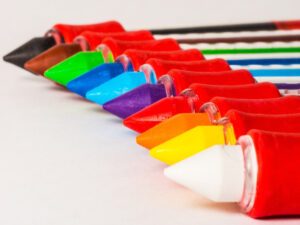Do you have a solid color jigsaw puzzle you want to solve? Don’t let your nerves get the best of your puzzle play as single color puzzles are fun!
How To Solve a Solid Color Jigsaw Puzzle?
I remember the first time I was assembling a solid color jigsaw puzzle with no discernible image might seem daunting at first glance. It was upsetting as a solid color jigsaw puzzle is all one color and a number of pieces. So I guess I learned almost immediately that the jigsaw puzzle box was no help (LOL) and that I needed to think about solving the solid color jigsaw puzzle differently.

When you deep into the fascinating world of a solid color jigsaw puzzle and explore the most efficient strategies for conquering these seemingly enigmatic puzzles with patterns and hues, you might be intrigued like I was. Whether you’re a seasoned puzzler who loves puzzle competitions or a jigsaw puzzle enthusiast, looking for a new challenge or a curious novice eager to expand your puzzle-solving repertoire, the mysteries of solving solid color jigsaws with precision, speed, and satisfaction is possible.
Table of Contents
A Step-by-Step Guide on How to Solve a Solid Color Jigsaw Puzzle
1. Sort the Pieces Completely
Begin by sorting the puzzle pieces into different groups based on their shapes. Solid color puzzles often have pieces with similar or identical shapes, so this initial sorting step will help you identify patterns and organize your workspace. Lay the pieces out in rows so you can easily see the shapes.
2. Identify Edge Pieces
Look for pieces with straight edges, as these are likely to be edge pieces. Separate them from the rest of the pieces and assemble them to form the outer border of the puzzle. This will provide a framework for building the rest of the puzzle. And it might look daunting at first, but it will complete the puzzle faster.
3. Create Sections
Divide the remaining pieces into smaller sections The sections need to be based on their shades or tones. Look for subtle variations in color or texture that may indicate different regions of the puzzle. Consider the grain of the paper as you view the pieces. Grouping similar pieces together will make it easier to tackle each section individually.
4. Focus on Gradations
With solid color puzzles, the key to success lies in identifying subtle gradations or variations in the color. Keep in mind, these will be so subtle variations that you might not see them on the jigsaw puzzle box image. Start by locating areas where the color shifts slightly, indicating the boundaries between different regions or features within the puzzle.
5. Work from the Inside Out
Once you’ve established the outer border and identified distinct sections within the puzzle, begin working from the inside out. Start with the areas that have the most noticeable variations in color or texture, as these will be easier to assemble.
6. Pay Attention to Shapes and Textures
While solid color puzzles may lack obvious visual clues, they often contain subtle variations in texture or shading that can help you distinguish between pieces. Pay close attention to these nuances as you fit the pieces together.
7. Trial and Error
Don’t be afraid to experiment and try different combinations of pieces. Sometimes, pieces that appear to be a perfect fit may not actually belong together, so be prepared for a bit of trial and error along the way.
8. Patience and Persistence
Solving a solid color jigsaw puzzle requires patience and persistence. Take your time, stay focused, and don’t get discouraged if progress seems slow. Celebrate small victories as you gradually piece together the puzzle.
9. Final Touches
Once you’ve assembled the majority of the puzzle, go back and double-check for any missing or misplaced pieces. Pay attention to subtle details and ensure that every piece fits snugly into place.
What is the most efficient way to solve a white jigsaw?
When faced with the seemingly daunting task of solving a white jigsaw puzzle, efficiency is key. The absence of distinct colors or patterns in a white jigsaw presents a unique challenge, requiring a methodical approach and keen attention to detail.
The most efficient way to tackle a white jigsaw puzzle is to first focus on identifying and assembling the edge pieces. Sorting through the pile to find straight-edged pieces and forming the outer border provides a solid framework for building the rest of the puzzle.
Once the border is in place, the next step is to divide the remaining pieces into smaller sections based on subtle variations in shade or texture. By breaking the puzzle down into manageable sections, puzzlers can systematically work their way through the intricacies of the puzzle, gradually filling in the blank canvas with precision and accuracy.
Additionally, employing the “negative space” approach can be particularly useful when solving a white jigsaw puzzle. Rather than solely relying on color or pattern cues, focus on the shapes of the pieces and the spaces between them. Look for clues in the negative space surrounding each piece to determine where it fits within the puzzle.
This method allows puzzlers to leverage the spatial relationships between pieces to piece together the puzzle efficiently. With patience, persistence, and a strategic mindset, solving a white jigsaw puzzle can become a rewarding and satisfying endeavor, showcasing the power of problem-solving and creative thinking in action.
A Single Color Jigsaw Puzzle if Fun to Play
Over time you will find what is the easiest way to solve a solid color jigsaw puzzle with your skills. One might expect that the task would be daunting, but what I’ve found is that it is a fun way to enjoy a puzzle challenge to the fullest! Just brace yourself for a bit and see how comfortable this type of jigsaw can be to play!
